What rifle influenced Kalashnikov’s famous carbine design more, the Garand M1, or the Haenel MP 43? This question was broached by blogger Jeff of TwistRate in a video posted to the Full30 gun video hosting website recently. Readers can follow the link to watch that video before reading my discussion of this question below.

A late war StG 44, virtually identical to the earlier MP 43. This rifle is often cited as being the forerunner of the AK series of rifles, but there is a compelling case to be made that the M1 Garand was a much greater influence on Kalashnikov’s design. Image source: rockislandauction.com
Whenever the AK’s history is discussed, it seems to come up: “Isn’t the AK just a Russian Sturmgewehr?” I am going to break this question up into five separate questions, and then examine seven aspects of the AK’s design which should help answer all five. The questions are as follows:
Is the AK a clone of the MP 43?
Was the AK inspired by/a response to the MP 43?
What was the MP 43’s influence on the AK’s design?
What was the M1’s influence on the AK’s design?
What evidence is there within the AK’s design itself of a connection between captured German small arms engineers and Kalashnikov and his design team?
Having established these questions as those we aim to answer, let’s move on to examining seven areas of the AK’s design that can give us more information.
I. The Bolt
Kalashnikov was an admirer of John Garand’s work, and it is here in the bolt that this was most clearly expressed, but paradoxically it is also where hints of what may be the MP 43’s influence show through clearly. Unlike the MP 43, but like the M1, Kalashnikov’s carbine uses a two-lug rotating bolt with generous sculpting of the locking lugs to give the bolt precise characteristics during both locking and unlocking. It’s very easy to see when the two bolts are compared how Kalashnikov emulated the hard work Garand did getting the lockup just right:

Later model AK bolts. Earlier models possess internal extractors that are partially covered by the bolt body. Note how the bolt has two chamfered and shaped locking lugs, but that one has been extended over the top of the bolt to give the carrier access to the repositioned cam lug. A false third lug is positioned below to ram the cartridges into the chamber. The AK’s bolt could be seen as a direct evolution of Garand’s system, shown below. Image source: forum.saiga-12.com

The M1 Garand’s bolt, for comparison. Note the same lug arrangement, but where the AK’s camming lug has been moved on top, the Garand’s camming lug is an extension of the right locking lug. The M1 rifle uses the bottom section of its bolt to feed, without a cartridge-ramming extension. Note that unlike the AK, the M1 also uses a spring-loaded ejector. Image source: thefiringline.com
Looking at the two bolts side-by-side, it seems obvious that the AK’s bolt is a derivative of Garand’s system, with a few minor changes. This is a comfortable explanation, until we look at the MP 43’s bolt face:

The front of the MP 43’s tilting bolt. The resemblance to the AK’s bolt is striking, despite the AK using an entirely different system of locking. The generous feeding lug, extractor, and fixed ejector cut all are dead-ringers for the AK’s distinctive bolt face profile. Thanks to Alex C. for providing me with this image.
As if that wasn’t hard enough to wrap our heads around, there are further considerations. First, while both the AK and MP 43 bolts bear an uncanny resemblance to one another, that does not rule out the possibility that their appearance might be coincidence. The AK’s bolt is mechanically much more M1 than it is MP 43, and if a designer did want to keep the basic M1 locking system while moving the operating rod to the top of the action, and raising the bolt to clear a fixed ejector (which was earlier present in the Soviet SVT rifle, and is therefore an ambiguous feature of the AK), then the result would necessarily resemble the MP 43’s bolt profile. It’s also important to not forget that the whole MP 43 bolt does not much resemble that of the AK, having an almost continuous cross-section until the end, and featuring an unlocking claw at the rear for the tilting bolt. In contrast, the AK bolt quickly reduces to a small diameter, to save weight and improve mass ratio.

The tilting-bolt SVT rifle also featured a fixed ejector, like the later MP 43 and AK rifles. Like early AK prototypes, the SVT also used a short-stroke gas operating rod. Image source: armimilitari.it
II. The Action Spring
The action spring of the M1 resembles that of the AK fairly closely if one imagines that during the design process it was relocated to behind the operating-rod-cum-bolt-carrier.
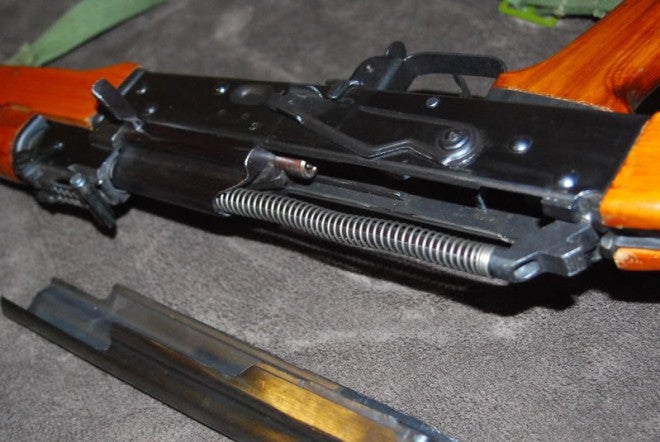
The AK utilizes a small-diameter action spring nestled inside the well-curved bolt carrier. Image source: forum.officer.com

The M1’s small-diameter action spring nests neatly into its operating rod like an AK’s, even producing curves suggestive of the latter rifle’s bolt carrier. However, as we’ll see there is a potentially more likely source of inspiration for the AK’s arrangement. Image source: typo.org
The MP 43’s arrangement contrasts greatly with the other two:

The MP 43 features a large-diameter action spring wrapped over the rearmost stud of the operating rod. Note also the claw-type unlocking mechanism of the MP 43’s tilting bolt.
However, one rifle that is impossible to ignore for its resemblance to the AK is, with its second mention in this article, the SVT:

The similarity of the SVT’s action spring arrangement to the AK’s, as well as their shared national origin makes it a more likely candidate for inspiration than the M1. Image source: gunpics.net
III. Trigger Group
The AK clearly carries on the Garand’s legacy in this respect, using the venerable Browning-designed double hook trigger that first originated in the Auto-5 shotgun.

The M1 Garand carries forward the legacy started with the Auto-5 shotgun, reincorporating Browning’s excellent simple double-hook trigger design. Image source: ammogarand.com

The AK’s trigger group is very similar to that of the M1 Garand, and by extension the Garand’s predecessors in using the Browning trigger design. It differs from the former primarily in the spring arrangement, as well as the addition of the automatic fire sear. Image source: youtube.com
To get a better sense of how this trigger design and the AK’s automatic fire sear work, I recommend watching the below animation of the AK’s automatic firing cycle. It should be noted that in semi-automatic fire the trigger would be caught before the bolt reaches battery by the secondary sear:
Contrasting with this simple trigger design is the MP 43’s trigger group:
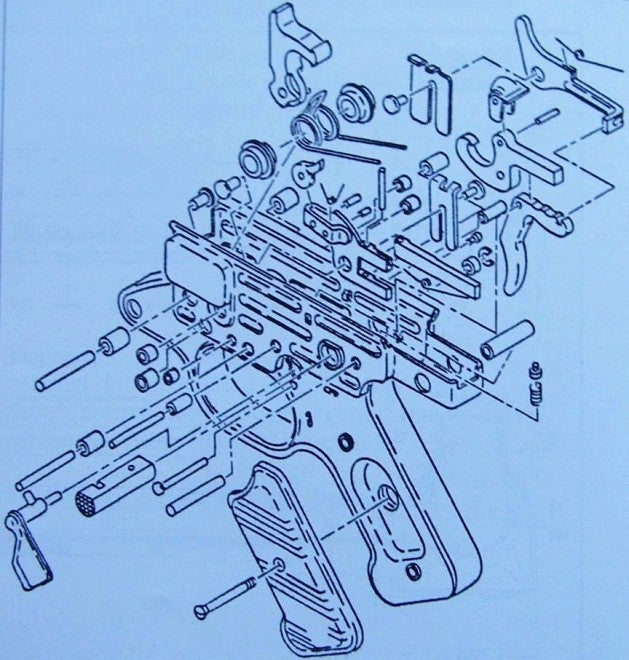
The trigger group of the MP 43. The operation of this trigger group in semi-automatic fire is analogous to the AK and Garand, but its execution is wildly more complex. Image source: forum.axishistory.com
IV. Cam Track
Being a tilting bolt design derived from the Czech ZB 26 machine gun, the MP 43 does not utilize a cam track for unlocking. Both the AK and M1 rifle do, and the similarities are a compelling argument for Garand’s influence:

The bolt carrier of a later-model AK. Visible is the bolt carrier’s cam track, which retains the generous clearance for the operating lug of the M1 Garand, underlug space to delay unlocking, and anti-preengagement shelf to prevent premature bolt rotation. Image source: avtomats-in-action.com
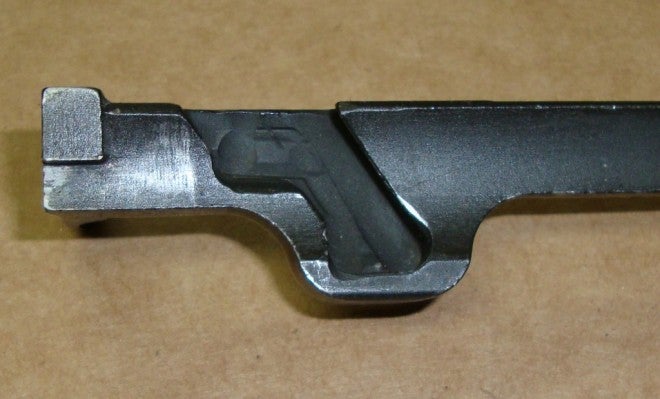
The M1’s operating rod, turned over to illustrate the similarities to the later Kalashnikov design, even to the extent that both tracks are machined in the same way. Highly visible is the vertical anti-preengagement shelf. Image source: ammogarand.com
V. Gas Sealing Rings
Like the AK, the M1 Garand utilizes a fixed gas piston connected directly to the operating components. Unlike the M1 Garand, the AK features sealing rings on its piston head, which are devices that create turbulence and mitigate gas leakage around the piston without addition tremendous complexity or requiring tightly fitting gas tubes.
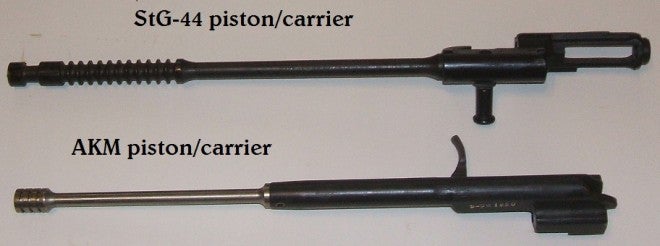
The gas sealing rings are visible on the operating rods of both the AK and StG-44 (a redesignation of the MP 43), however note the greatly reduced number on the former’s. Image source: forgottenweapons.com
So is the MP 43 the origin of the AK’s gas sealing rings? It certainly isn’t the immediate origin, as the Russian SKS rifle’s operating rod possesses gas sealing rings very similar to those on the AK, but there is a possible Russian progenitor of the design that predates even the MP 43: The seemingly ever-present SVT.

The SVT’s gas piston arrangement is inverted compared to the SKS’s, with a female oprod end and a male gas block, but apparent are gas sealing rings of a style much closer to the Simonov and Kalashnikov type than the MP 43. Image source: forums.gunboards.com
VI. Hinged Receiver
The AK rifle does not have a hinged receiver, but its prototype – the short-stroke piston operated AK-46 – did, and it is therefore worth examining its similarities and differences with the MP 43, which also has this feature. Both rifles hinge in the same place, behind the magazine, but there are other differences.

The AK-46. The receiver hinges behind the magazine, like an MP 43. In this arrangement, the lower receiver is the male end, while the upper is female. Note the short-stroke gas piston with gas sealing rings, highly reminiscent of the SKS carbine designed two years earlier. Image source: world.guns.ru
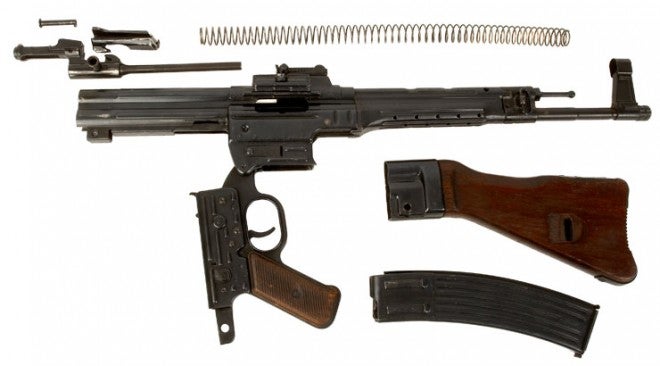
A demilled StG-44. The MP 43 rifle hinges in the same way as the AK-46. Though this arrangement was deleted in the later AK-47 rifle, it does still imply that the MP 43 was a direct influence on the design. Image source: guns-pictures.drippic.com
There is another potential origin of the design, however. After he sustained injuries as a tank commander in the Second World War, Mikhail Kalashnikov retired to his hospital bed, and began to work on a submachine gun in 1942 that would give him his first foothold in Soviet small arms design. This submachine gun, which predated any Soviet encounter with the MP 43 or its predecessor the MKb.42(H), also featured a hinged receiver, albeit one that pivoted in front of the magazine, not behind it.

The 1942 Kalashnikov submachine gun. This design was deemed too complex, but creative, and was Kalashnikov’s first major foray into firearms design. Image source: firearmsworld.net
VII. Layout
This brings us to our final consideration, that of the rifle’s layout. It’s undeniable that the basic form, appearance, and function of the AK and MP 43 rifles is much more similar to each other than either are to the M1 Garand. It is also true that the Soviet 7.62x41mm intermediate rifle cartridge – around which the AK rifle was originally designed – was a direct response to the German 7.92x33mm (the latter cartridge being mentioned by name in the original requirement that produced the Soviet round). In this way, yes, the AK as a whole was directly inspired by the MP 43, and it owes much to that rifle. However, it’s important not to leave things there. Neither the AK nor the MP 43 were created in a vacuum; a great plethora of designs existed at the same time from which designers of both drew ideas and mechanisms to create weapons suitable for the mobile battlefield. Where one could draw parallels between the AK’s top mounted gas system, staggered column detachable magazine, sights, pistol grip, and overall rude appearance with the German design, so too could they draw those between it and other Russian designs, such as the PPS-43, SVT, or AS-44 assault rifle. Russian assault rifle developments before the MP 43 are obscure at best, but the concept would have been known at the time; the German effort to create a select-fire intermediate rifle did not arrive unheralded. Was the MP 43 a spur in the Russian small arms designers’ flanks? Undoubtedly, but it’s difficult to imagine that with the many precedents that had existed for years prior, the Russian engineers would have been totally unaware that such a thing as an assault rifle could exist.
So, we can finally answer our five questions:
Is the AK a clone of the MP 43?
Certainly not.
Was the AK inspired by/a response to the MP 43?
It certainly was a response to the German rifle, but Russian engineers would have been aware of the concept previously.
What was the MP 43’s influence on the AK’s design?
Here and there, there are details that may be indicative of some design DNA transfer, but mechanically speaking the MP 43 can claim only marginal influence.
What was the M1’s influence on the AK’s design?
Kalashnikov explicitly names Garand as an influence, in his correspondence with Edward Ezell*, and the design details of his rifle bear out this claim.
What evidence is there within the AK’s design itself of a connection between captured German small arms engineers and Kalashnikov and his design team?
Without direct evidence of major design features being carried over from the MP-43 or other German designs to the AK, and without any primary sources documenting German engineers working with or under Kalashnikov in his team, this connection remains decidedly speculative.
*Page 67, Kalashnikov, The Arms and The Man
 Your Privacy Choices
Your Privacy Choices

